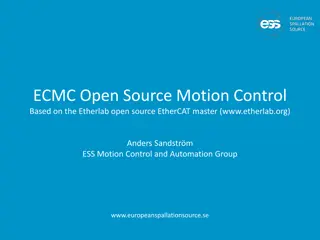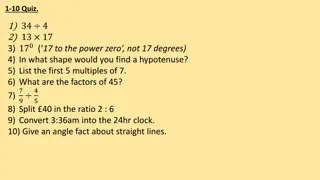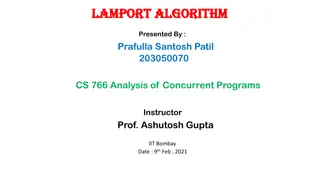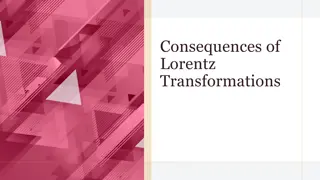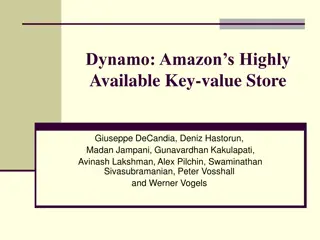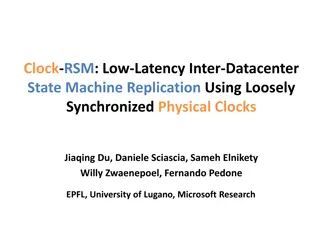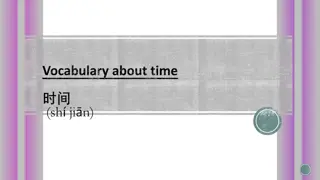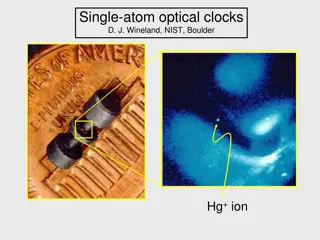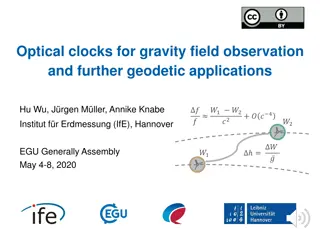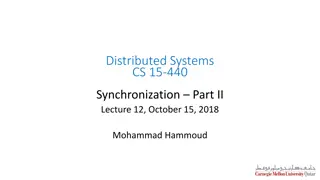
Consistency in Distributed Systems with Leslie Lamport
Explore the importance of consistency in distributed systems through key papers by Leslie Lamport, focusing on time, clocks, event ordering, and global state determination. Learn about establishing order in asynchronous systems, coordination challenges, and practical applications like airline ticket reservations in distributed databases. Discover the background of Leslie Lamport and his contributions to the field.
Download Presentation

Please find below an Image/Link to download the presentation.
The content on the website is provided AS IS for your information and personal use only. It may not be sold, licensed, or shared on other websites without obtaining consent from the author. If you encounter any issues during the download, it is possible that the publisher has removed the file from their server.
You are allowed to download the files provided on this website for personal or commercial use, subject to the condition that they are used lawfully. All files are the property of their respective owners.
The content on the website is provided AS IS for your information and personal use only. It may not be sold, licensed, or shared on other websites without obtaining consent from the author.
E N D
Presentation Transcript
Cornell CS 6410, 10/5/2017 Today s Theme: Consistency in a Distributed System Papers: Time, Clocks, and the Ordering of Events in a Distributed System, Leslie Lamport, Communications of ACM,Volume 27 Issue 7, July 1978. Distributed Snapshots: Determining Global States of Distributed Systems, K.Mani Chandy, Leslie Lamport. ACM Transactions on Computer Systems (TOCS), Volume 3 Issue 1, Feb. 1985.
Why should we care about this theme? How can we make a consistent global state of an asynchronous system? What even is our synchronous protocol? Who today is asking/using these questions? How can we coordinate in a distributed system? If an (airline) reservation database system is replicated and distributed and people can purchase tickets locally, how can we order the purchasing of tickets (e.g. two people want to buy a seat, but only one seat is left)?
Why should we care about these papers? Why to care about the set Time, Clocks, and the Ordering of Events in a Distributed System, Leslie Lamport, Communications of ACM,Volume 27 Issue 7, July 1978. Distributed Snapshots: Determining Global States of Distributed Systems, K.Mani Chandy, Leslie Lamport. ACM Transactions on Computer Systems (TOCS), Volume 3 Issue 1, Feb. 1985. 5414?
Todays Goals Time, Clocks, and the Ordering of Events in a Distributed System, Leslie Lamport, Communications of ACM,Volume 27 Issue 7, July 1978. o Understand: The happened before relation How to establish partial/total order and what to do with it Physical, logical, local/global clocks Distributed Snapshots: Determining Global States of Distributed Systems, K.Mani Chandy, Leslie Lamport. ACM Transactions on Computer Systems (TOCS), Volume 3 Issue 1, Feb. 1985. o Understand: Global Snapshot Consistent Cut
Time, Clocks, and the Ordering of Events in a Distributed System Leslie Lamport Massachusetts Computer Associates, Inc. Communications of the ACM - July 1978
Leslie Lamport BS in Math from MIT, 1960 MA, Ph.D. in Math from Brandeis, 1972 Research in industry Massachusetts Computer Associates (1970-77) SRI International (1977-85) DEC/Compaq (1985-2001) Microsoft Research (2001-) 2000 PODC Influential Paper award for Time, Clocks, and the Ordering of Events 2013 Turing Award Winner and initial developer of LaTeX
Author: Leslie Lamport Massachusetts Computer Associates, Inc. COMPASS Out of their Minds: The Lives and Discoveries of 15 Great Computer Scientists By Dennis Shasha, Cathy Lazere pg. 125
Outline Partial Ordering of Events Logical Clocks Total Ordering of Events Anomalous Behaviour Physical Clocks
Definitions and Perspectives A process as a set of events with an a priori total ordering -- a sequencing. System as a collection of processes, each process as a sequence of events sending/receiving a message as an event in a process
Happened before relation, (Lamport 559)
a ? a a a an irreflexive partial ordering on the set of all events in the system
I.e., what can we say from a b? a b means a can causally affect b Concurrency? Two events are concurrent if neither can causally affect the other.
Outline Partial Ordering of Events Logical Clocks Total Ordering of Events Anomalous Behaviour Physical Clocks
Logical Clocks How might we begin thinking about clocks? We begin with an abstract point of view in which a clock is just a way of assigning a number to an event, where the number is thought of as the time at which the event occurred (Lampson 559) a clock Ci, for each process Pi, as a function assigning a number Ci(a) to any event a in Pi system of clocks as a function C assigning to any event b the number C(b) such that C(b) =Cj(b) if b is an event in Pj yet relating numbers Ci(a) to physical time, instead regarding Cias logical clocks Use of counters rather than use of an actual timing mechanism
Correctness? Physical timing of events order of events If an event a happens before another event b, a should happen at an earlier time than b Time?? Clock Condition For any events a, b: if a b then C(a) < C(b) Why can we not assume the converse as well?
Happened before relation, (Lamport 559)
Correctness Clock Condition For any events a, b: if a b then C(a) < C(b) 2 conditions to satisfy the Clock Condition: 1. If a and b are events in a process Pi, and a comes before b, then Ci(a) < Ci(b) There must be a tick line between any two events on a process line 2. If a is the sending of a message by process Piand b is the receipt of that message by process Pj, then Ci(a) < Cj(b) Every message line must cross a tick line ...Tick lines?
Problem with Partial Order A single resource Processes must synchronize to avoid conflicts Requests must be granted in order
Problem with Partial Order A single resource Processes must synchronize to avoid conflicts Requests must be granted in order Partial order is not helpful in solving this problem as partial order cannot resolve concurrent requests Total ordering required ..
Outline Partial Ordering of Events Logical Clocks Total Ordering of Events Anomalous Behaviour Physical Clocks
Total Ordering of Events Total ordering eliminates concurrency Identify message with event sending it
Distributed Mutual Exclusion Every node i has a request queue qi keeps requests sorted by logical timestamps (total ordering enforced by including process id in the timestamps) To request critical section: 1)send timestamped REQUEST(Tm:Pi) to all other nodes 2)put (Tm:Pi) in its own queue On receiving a request (Tm:Pi): 1)send timestamped REPLY to the requesting Node i 2)put REQUEST (Tm:Pi) in the queue
Distributed Mutual Exclusion Process i enters critical section if: 1)(Tm:Pi) is at top of its own queue, and 2)process i received a message (any message) with timestamp larger than (Tm:Pi) from all other nodes. To release critical section: 1)Process i removes its request from its own queue and sends a timestamped RELEASE message to all other nodes. 2)On receiving a release message from i, i s request is removed from the local request queue.
Distributed Mutual Exclusion Process i enters critical section if: 1)(Tm:Pi) is at top of its own queue, and 2)process i received a message (any message) with timestamp larger than (Tm:Pi) from all other nodes. Why is this condition required? To release critical section: 1)Process i removes its request from its own queue and sends a timestamped RELEASE message to all other nodes. 2)On receiving a release message from i, i s request is removed from the local request queue.
Total Ordering of Events Step 1: Pisends request resource Pisends request Tm:Pito Pj Piputs request Tm:Pion its request queue
Total Ordering of Events Step 1: Pisends request resource Pisends request Tm:Pito Pj Piputs request Tm:Pion its request queue
Total Ordering of Events Step 2: Pjadds message Pjputs request Tm:Pion its request queue Pjsends acknowledgement Tm:Pjto Pi
Total Ordering of Events Step 2: Pjadds message Pjputs request Tm:Pion its request queue Pjsends acknowledgement Tm:Pjto Pi
Total Ordering of Events Step 3: Pisends release resource Piremoves request Tm:Pifrom request queue Pisends release Tm:Pito each Pj
Total Ordering of Events Step 3: Pisends release resource Piremoves request Tm:Pifrom request queue Pisends release Tm:Pito each Pj
Total Ordering of Events Step 4: Pjremoves message Pjreceives release Tm:Pifrom Pi Pjremoves request Tm:Pifrom request queue
Message Complexity? 3(n 1) messages per critical section invocation Requests are granted in the increasing order of timestamps
Message Complexity? 3(n 1) messages per critical section invocation Requests are granted in the increasing order of timestamps Ricart Agarwala 2(n -1) , also doesn t require FIFO assumption Roucairol Carvalho - (0 , 2(n 1) ] based on request pattern
Outline Partial Ordering of Events Logical Clocks Total Ordering of Events Anomalous Behaviour Physical Clocks
Strong Clock Condition Now what?
Outline Partial Ordering of Events Logical Clocks Total Ordering of Events Anomalous Behaviour Physical Clocks
Physical Clocks One of the mysteries of the universe is that it is possible to construct a system of physical clocks which, running quite independently of one another, will satisfy the Strong Clock Condition (Lamport 562)
Summary Partial Ordering of Events Logical Clocks Total Ordering of Events Anomalous Behaviour Physical Clocks
Distributed Snapshots: Determining Global States of Distributed Systems Ph.D from MIT in Electrical Engineering Was in University of Texas at Austin, CS Department from 1970 89 Simon Ramo Professor at CalTech Member of National Academy of Engineering IEEE Koji Kobayashi Award(1987) A.A. Michelson Award(1985) K. Mani Chandy BS in Math from MIT, 1960 MA, PhD in Math from Brandeis, 1972 Research in industry Massachusetts Computer Associates (1970-77) SRI International (1977-85) DEC/Compaq (1985-2001) Microsoft Research (2001-) 2000 PODC Influential Paper award for Time, Clocks, and the Ordering of Events 2013 Turing Award Winner and initial developer of LaTeX Leslie Lamport
What is a Snapshot? Just a collection of local states of processes and channels!



